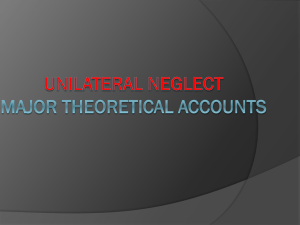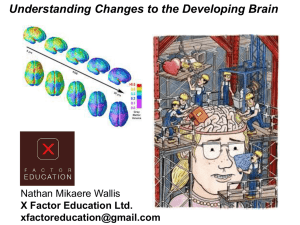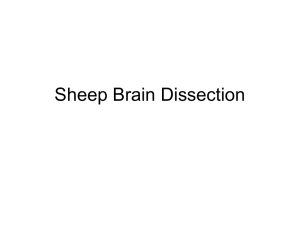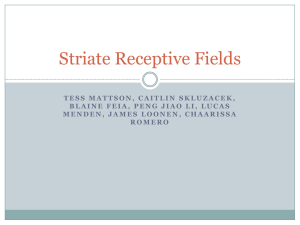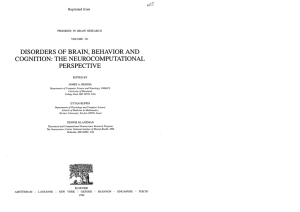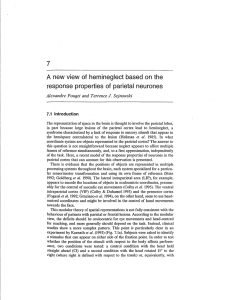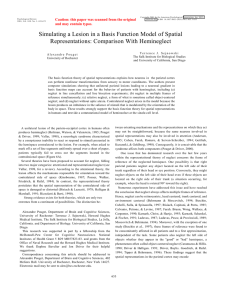Nov. 19
advertisement
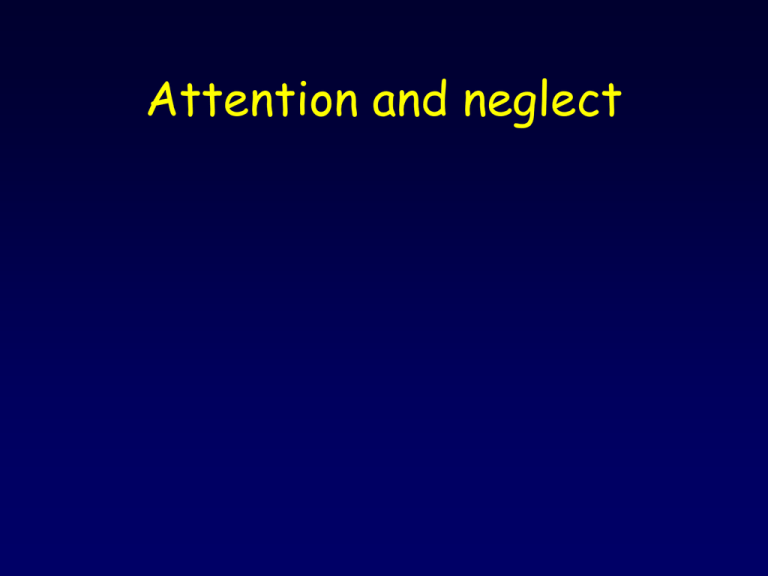
Attention and neglect Neurophysiology of Attention • The Superior Colliculus • MT, MST and PPC • V2, V4 and IT Neurophysiology of Attention • The Superior Colliculus • MT, MST and PPC • V2, V4 and IT The Superior Colliculus Receptive Field The Superior Colliculus Receptive Field Saccadic Enhancement The Superior Colliculus Receptive Field Is the saccadic enhancement in the superior colliculus due to attention or to a motor intent? The Superior Colliculus Receptive Field Attention alone can increase the firing rate Receptive Field •Response enhancement could correspond to the selection of the attended target •This enhancement seems to be independent of the behavior Physiology of Attention • The Superior Colliculus • MT, MST and PPC (the posterior parietal cortex) • V4 and IT (the infero temporal cortex) Treue and Maunsell, 1999. MST • Response to the attended stimulus is enhanced • Enhancement is stronger when the distractor and the target are in the same receptive field • The response to the distractor is decreased * Cue Firing Rate PPC: Gottlieb and Goldberg, 1998 1st Cue: Triangle Saccade 2nd Saccade + Time 1st Saccade Firing Rate * + Cue: Circle 2nd Saccade Time Cells in MT and PPC: Attention boosts the gain of the response to the attended stimulus while reducing the response to the unattended stimulus. Physiology of Attention • The Superior Colliculus • MT and PPC (the posterior parietal cortex) • V2, V4 and IT Reynolds et al, 1999 Monkey attends preferred stimulus of the cell Reynolds et al, 1999 Monkey attends null stimulus for the cell McAdams and Maunsell, 1999 Colored Gaussian McAdams and Maunsell, 1999 McAdams and Maunsell, 1999 What’s going on? • Maunsell: – Gain modulation – No baseline shift – Seen everywhere although strongest when the distractor and the target are in the same receptive field • Desimone: – Not gain: normalization – Baseline shift – Seen only when the distractor and the target are in the same receptive field Neglect Line Cancellation Line Bisection Patient: Frederico Fellini Karnath et al., 1993 Patients: Right Parietal Task: Shape Identification Condition 1 Condition 2 % Correct Right Target Left Target Prediction for Retinocentric Neglect Condition 1 Condition2 % Correct Right Target Left Target Prediction for Trunk-centered Neglect Condition 1 Condition2 Patient 1 C1 C2 % Correct % Correct Patients Patient 2 C1 C2 Frames of reference for neglect: Trunk-centered? Left hand is neglected Left hand is still neglected even though it is now on the right Can neglect be object-centered? Object-centered or relative neglect? Object-centered or relative neglect? Draw the black half Draw the white half Axis-centered neglect Main axis Hard Easy Driver et al, Neuropsychologia, 1994 Frames of Reference of Neglect • Neglect always affects a mixture of egocentric frames of reference for all behaviors • Neglect is always relative • In some patients, it can also be axiscentered (object-centered). • Can we relate the behavior of hemineglect patients to the response of neurons involved in spatial representations? • What do we know of the response properties of neurons involved in spatial representations? Eye Position Activity ex = -20 ex = 0 ex = 20 -40 –20 0 20 Retinal Location (deg) (Andersen et al., 1985) 40 Motor commands, M, are non linear functions of sensory inputs, S, and posture signals, P: M = f(S,P) Such functions can be approximated by linear combinations of basis functions, Bi(S,P): M = S ci Bi(S,P) Claim: parietal neurons compute basis functions Activity Eye Position Activity ex = -20 ex = 0 ex = 20 -40 –20 0 20 Retinal Location (deg) 40 Superior Colliculus Retinotopic Map Premotor Cortex Head-Centered Map Eye Movements Reaching Eye Position Basis Function Layer (Parietal Cortex) Retinal Location Eye Position Units Retinotopic Map Visual Cortex Can we generalize the basis function theory of spatial representations to object-centered representations? Neuronal Activity Trials Left of the object Right of the object Neuronal Activity Left of the object Trials Right of the object Activity Left of the object Saccades Direction (deg) Right of the object Explicit object-centered neurons or gain modulated neurons? Neuronal Activity Left of the object Trials Right of the object Activity Left of the object Saccades Direction (deg) Right of the object It appears that the parietal cortex uses basis functions for spatial representations in: • Egocentric coordinates (eye-, head-, bodycentered) • Object-centered coordinates Superior Colliculus Retinotopic Map Premotor Cortex Head-Centered Map Eye Movements Reaching Eye Position Basis Function Layer (Parietal Cortex) Retinal Location Eye Position Units Retinotopic Map Visual Cortex Right Right Eye Position Premotor Cortex Head-Centered Map Eye Position Superior Colliculus Retinotopic Map Left Retinal Position Right Left Map Left Basis Function Layer Retinal Position Right Right Map Eye Position Units Retinotopic Map Visual Cortex Main assumptions of the hemineglect model: • Parietal neurons compute basis functions • Basis function units are distributed across hemispheres according to contralateral gradients Right Right Eye Position Premotor Cortex Head-Centered Map Eye Position Superior Colliculus Retinotopic Map Left Retinal Position Right Left Map Left Basis Function Layer Retinal Position Right Right Map Eye Position Units Retinotopic Map Visual Cortex Saliency: summed activity in the basis function layer Saliency Model Error Error Patients Line Length Error Error Line Length Model Line Orientation Patients Line Orientation Karnath et al., 1993 Patients: Right Parietal Task: Shape Identification Condition 1 Condition 2 Right Target Left Target Model Condition 1 Condition 2 Left Stimulus Right Stimulus C2 C1 Left hand is neglected Left hand is still neglected even though it is now on the right General principle: any change of posture toward the ipsilesional side results in an improvement in performance (extreme case: vestibular recovery) Relative neglect Draw the black half Draw the white half Object-centered neglect Activity in the Basis Function Layer Main axis Hard Easy Conclusions • Parietal neurons compute basis functions of their inputs. As a result, they encode the location of objects in multiple frames of reference simultaneously • A lesion of a basis function representation leads to a syndrome similar to hemineglect if the basis functions are distributed across hemispheres according to contralateral gradients • This approach can be generalized to objectcentered representations

